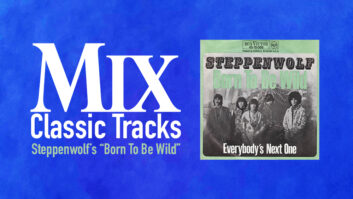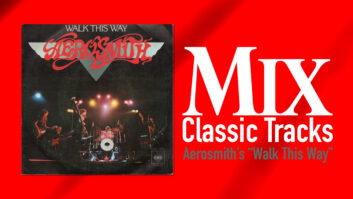If all Lou Reed’s groundbreaking single “Walk on the Wild Side” had ever done was put oral sex explicitly onto the radio and into the pop-culture lexicon, that would have been enough. But the track, from the 1972 Transformer LP, was seditious in a number of other ways. It was a portal into the mysterious pharmaceutically powered and androgynous scene that swirled around Andy Warhol and the New York art world, featuring references to drag queens Holly Woodlawn (“Holly came from Miami F L A…Shaved her leg, then he was a she”) and Candy Darling (the aforementioned fellatial reference), as well as Jack Kerouac-by-way-of-William Burroughs hustlers like Joe Dallesandro (“Little Joe never once gave it away/Everybody had to pay and pay”). But it wasn’t just proto-snarky cultural references that made “Wild Side” so archly fun. Bassist Herbie Flowers’ haunting bass line, which is spread between an acoustic double bass and a Fender electric bass, is instantly recognizable and has been sampled hundreds of genre-crossing times; and the nonsense refrain of “Doo, doo-doo, doo-doo, doo-doo doo,” sung by “the colored girls” — actually three white English girls collectively and professionally known as Thunder Thighs — is the slouching Greek chorus of rock ‘n’ roll.
Engineer Ken Scott — who cut his teeth on Beatles recordings at Abbey Road in the 1960s and would go on to engineer and produce records for Jeff Beck, Elton John and Duran Duran — had already finished The Rise and Fall of Ziggy Stardust and the Spiders From Mars with David Bowie, who would produce this record for Reed. Scott was an adventurous but well-grounded record maker who meshed well with the innovative but calculating Bowie, an anchor of practicality as glam-rock moved from its salad days into its own business sector clad in $1,000 snakeskin boots and make-up. Scott was comfortable at Trident Studios, in London’s SoHo district, in a five-story former printing factory. The single main studio reminded him of Abbey Road’s Studio Two — The Beatles’ room — with its control room looking down on the studio from a floor above. Trident’s founders, brothers Norman and Barry Sheffield, were yet to develop the Trident brand into one of the classic marquees of the console business with the sublime A-Range and the workhorse Series 80. Scott says it was likely a 20-input/16-output Sound Techniques console in the control room in 1972 for Transformer, sideloaded into the room and underneath a pair of large Tannoy speakers in Lockwood Audio cabinets. There were two each Universal Audio LA-2As and UREI 1176 compressors in the rack next to the console. An EMT plate was the sole reverb.

The recording studio was sizable enough to hold a 45-piece orchestra, with a drum booth recessed into a cubby underneath the control room. “Walk on the Wild Side” was one of 11 songs on Reed’s Transformer album, and Scott approached the recording of it like any other project. “I make it a point to never listen to the lyrics, so I wasn’t shocked by anything,” he says. “I was listening to the melodies and the sound. I mean, we were doing this right in between Ziggy and Aladdin Sane, so Lou didn’t seem that out-there by comparison.”
On the drum kit, played on this track by Ritchie Dharma, Scott placed an AKG D-12 dynamic on the kick; a Sony C-38 on the snare, angled in at about 45 degrees; and either a Beyer M160 or an STC 4038 overhead. Scott says that by this time, he had started recording drums in stereo, and on this song likely put the kick on its own track and mixed the snare and overhead microphones in stereo to the 3M 16-track deck running at 15 ips with Dolby NR. (Trident was the first UK studio to use Dolby.)
Herbie Flowers was playing a stand-up double bass in the room, on which Scott likely experimented with a Neumann KM 56 wrapped in sponge material and stuffed into the bridge, a technique he had used successfully recording Stanley Clarke. An acoustic guitar, played by the late Mick Ronson, Bowie’s collaborator and co-producer on Transformer, was recorded with two AKG C-12As. The microphones were placed at an angle of 45 degrees down from the front of the instrument and facing 45 degrees to its rear. A second mellow-sounding electric guitar is also on the track, with a U67 on the amplifier.
As regular readers of “Classic Tracks” are aware, basic tracks in the early multitrack era were not drawn-out affairs, and “Walk on the Wild Side” was no exception; Scott figures the band nailed it within three or four passes. But a lot went on during the run-up — the band learned the song and rehearsed it, and Scott tweaked the sounds, though neither party was restricted to one side of the glass or the other. Initially, Dharma started running the song down with drumsticks. “I heard it and it sounded like he was playing a march, so I ran down and suggested he try it with a pair of brushes,” Scott recalls.
Classic Tracks: Kool & The Gang’s “Celebration”
The first overdub was the trademark bass line. Flowers laid a Fender bass on top of the acoustic one, with perfectly matched glissandos on each. Then came Reed’s vocals. He stood in front of a U67, and it may have been more like an actor delivering his lines than a singer doing a vocal. With Bowie and Ronson rehearsing during the evenings for a forthcoming live show at the Rainbow Theatre in London, Transformer‘s session hours were curtailed to the daytime (not exactly Reed’s best milieu) and Scott was concentrating on getting the tracks done. He found it best not to intrude into Reed’s odd, uncommunicative state of mind and simply let him perform. “It was a strange time,” Scott recalls. “David wasn’t around much, he was off with Rono rehearsing for the show, and I had no idea where Lou was. I mean, his body was there, but I’m not sure about the rest of him.” (Two weeks after the project wrapped, Scott was in a Chinese restaurant in SoHo when several RCA Records executives came in with Reed in tow. “He had no idea who I was,” Scott says.) Reed’s vocal required a touch of one or the other of the compressors and a little EQ, and little else other than the occasional punch.
Next came the background vocals, the famous “Doo, doo-doo, doo-doo, doo-doo, doo” performed by Karen Friedman, Dari Lalou and Casey Synge — who had become sought-after backup singers in the London studio scene and would go on to chart singles as Thunder Thighs with titles such as “Central Park Arrest” and “Dracula’s Daughter.” “David said we need some girls on this track, and I put in a call to them,” says Scott, who had used them on a previous project. He grouped them around the U67 and “Doo, doo doo” went into the history books quickly.
“Walk on the Wild Side” also has a string section, the kind of contrast that Bowie thrived on and Ronson was perfect to execute. Transformer has strings on some of its other songs, too, but when the string session came around to this one, for some reason the violas and cellos were nowhere to be found. Thus, there are only violins doubling up on Ronson’s simple, single-note lines, forlorn and almost Celtic, the antithesis of lush, into the U67s Scott had set up. It was emblematic of how Bowie and Ronson approached the production of the record: Bowie’s visionary conceptions made manifest by Ronson’s visceral touch, though there was a more prosaic side to the equation, too. “Lou found it hard to understand Rono’s northern English accent and David would have to translate for him,” says Scott.
The last bit of the song is the saxophone solo, performed by Ronnie Ross, which plays the song out to its fade. Scott set up two U67s, one on the bell and the other facing the upper valves of the sax, both less than a foot back. “So much of the sound comes from the upper microphone,” he says. “That’s where the breathiness is.”
Scott had developed his own unique method of mixing, born out of a lack of extra hands to make moves in the pre-automation days. He would break the song into sections, mix them individually on the Studer 2-track, splicing the ¼-inch tape sections together as he went from one section to the next. “There wasn’t even a second [engineer] with me in the studio,” he recalls. “David was on the Queen Elizabeth sailing to New York. He had to leave early because he refused to fly after a near accident. So I’d break it into short sections and mix them bit by bit.”
The mix for “Walk on the Wild Side” is hardly radical — the electric and acoustic guitars are split left and right, and the rest of the track seems right down the middle — but the reverb on the background vocals is notable. The women are introduced surrounded by a dense halo of reverb, from which they emerge, the sound morphing into an intimate breath in your ear. “I had to do something — how many times can you hear ‘doo, doo, doo’ without getting bored?” Scott asks. He set the background vocal track echo send pre-fader (it was going to an EMT plate), so as he brought the background vocal track up progressively, the reverb return stayed at the same level. The effect is three-dimensional, adding depth and motion as a counterpoint to Reed’s deadpan delivery.
All of Transformer took little more than three weeks to make, start to finish. Scott says that’s part of what made it such a good record. “You got to the point quickly recording that way,” he says. The song became the only charting single of Reed’s career, making it as high as Number 16 in the winter of 1973. Big things were ahead, however. In 1974, his dynamic Rock ‘n’ Roll Animal live album (with extended versions of Velvet Underground classics written by Reed such as “Sweet Jane,” “Heroin” and “Rock ‘n’ Roll”) went Gold and brought in a new generation of fans for the idiosyncratic artist. But it’s “Walk on the Wild Side” that has survived the decades and is acknowledged as one of rock’s greatest tunes.







